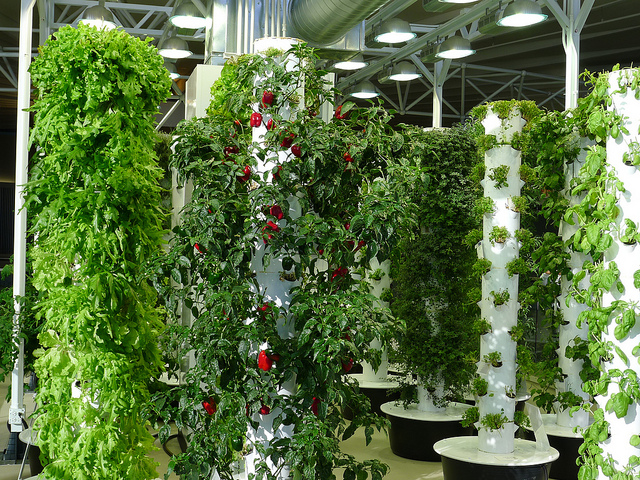Demand for fresh produce — whether as the star of a dish or a delicate garnish — is on the rise as consumer interest in both local and plant-based foods continues to grow. Vertical gardens can provide a source of herbs, leafy greens and other produce for urban farms and restaurants that have minimal space, the founders of two Washington, D.C. vertical farming operations said at an event presented last month by Smithsonian Associates.
Cultivate the City launched in 2015 with a mission to “turn underutilized space into food,” and the garden center now has 20 food-producing sites across the city totaling 1 acre, founder and CEO Niraj Ray said. The company emphasizes education and partners with schools and community gardens, and also serves local restaurants and foodservice operations.
Wholesale for restaurants and foodservice operations is the main business of Little Wild Things City Farm, which launched in 2014 and grows the majority of its crops in the basement of a local restaurant.
Vertical gardens expand possibilities for roof- (or basement) to-table farming
When Little Wild Things was just beginning to sprout, founder Mary Ackley mentioned to one of her early customers that she was looking for a space to set up her indoor vertical farm. The Pub & The People, which had just recently opened, had free space in its basement, and Ackley “measured the space and moved in within a couple weeks,” she said. Microgreens and edible flowers are Little Wild Things’ specialties, so the 300 square-foot space provides plenty of room for the stacked-up garden to grow. Shelves around the room hold trays of microgreens growing in soil, under a mix of LED and fluorescent lights.
While the basement suits Little Wild Things just fine, many of Cultivate the City’s urban gardens are perched on rooftops around the city, which maximizes sun exposure and doesn’t take up any indoor space. The company partners with Bidwell Restaurant located in the Union Market food hall for its rooftop garden, and manages the rooftop farming operation crowning Nationals Park.
Small farms provide big benefits for chefs, restaurants
Some of the vegetables grown on top of Nationals Park find their way onto the dishes served to stadium-goers, and sourcing produce from just a few stories away gives chefs access to fruits and vegetables at the peak of freshness, with no concerns about them being damaged in transit.
Vertical farming is an ideal way to grow delicate produce like leafy greens and soft fruits, since nothing touches the ground. Ray said the method is “meant for strawberries,” and it also works well for microgreens and herbs that can easily be crushed. Vertical herb planters allow chefs to trim leaves as needed. “We offer 10 to 12 different kinds of mint,” Ray said, rattling off different varieties ranging from spearmint to grapefruit mint. Some local restaurants use vertical planters with a different type of mint on each level as a fixture in their bar programs, allowing patrons to craft a “custom mojito,” he said.
Little Wild Things sells its microgreens to “a number of restaurants around the city…our restaurant customers range from food trucks to fast-casual restaurants to fine-dining and Michelin-starred restaurants,” Ackley said. She’s constantly fielding suggestions from local chefs looking for new microgreens — from micro shiso to micro sesame. The company also offers more than 15 varieties of edible flowers — something they didn’t realize there was demand for until a restaurant that received an order of micro radish greens with some blossoms attached asked if they could re-order just the flowers, which have a spicy flavor.
DIY: Growing your own vertical garden
For restaurants that have a little space to spare and the desire to grow their own vertical garden, Ray suggested several systems, including self-watering options from Tower Garden and simpler set-ups like the VEG Tower and Root Pouch that can be watered by hand or set up with a simple watering system.
While hydroponic and aeroponic farming are methods of vertical farming, Cultivate the City and Little Wild Things both rely on a growing medium, since hydroponic and aeroponic methods can be costly and complicated. Little Wild Things grows its microgreens in soil, and Cultivate the City uses a planting medium made from coconut waste product called coconut coir that can be mixed with soil and other materials.
Ackley and Farm Manager Chelsea Barkley described the process of planting and sprouting microgreens, which can be done in small, shallow containers since the greens are ready to harvest when they are only 8-21 days old. Little Wild Things now harvests about 1,400 pounds of produce from its indoor vertical farm, but Ackley and Barkley learned as the business grew — neither had any previous professional farming experience.
“We totally taught ourselves to farm with YouTube,” Barkley said.
_________________________________________________
If you enjoyed this article, join SmartBrief’s email list for more stories about the food and beverage industry. We offer 20 newsletters covering the industry from restaurants to food manufacturing.
